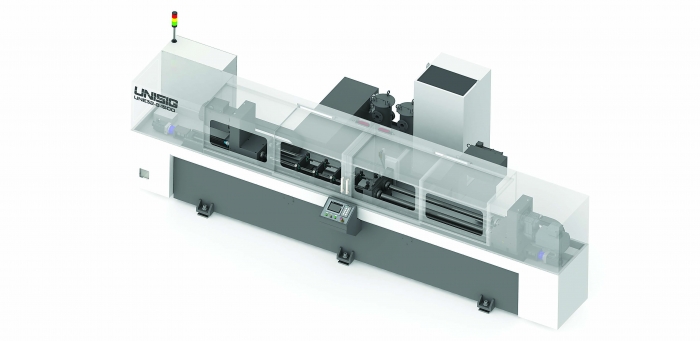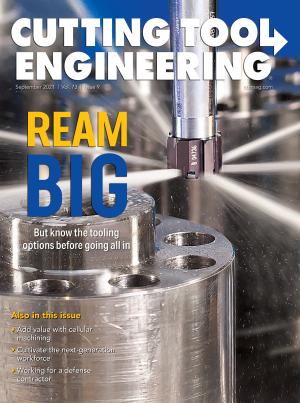Guns aren’t the only metal products that require holes with high depth-to-diameter ratios. So the latest generation of UNE series gundrilling machines also can help manufacturers in the automotive, medical, energy, defense and aerospace industries hit production targets.
Made by Unisig in Menomonee Falls, Wisconsin, UNE series machines are billed as a good fit for high-volume/low-mix or low-volume/high-mix manufacturing environments. With five models built from two frame sizes, the UNE series can drill hole diameters from 1.4 mm to 40 mm (0.06" to 1.57") and depths up to 3,000 mm (118"). Two single-spindle models offer maximum hole diameters of 25 mm (0.98") and 40 mm while the three two-spindle models in the series can drill holes up to 12 mm (0.47"), 20 mm (0.79") and 32 mm (1.26") in diameter.
The single main-spindle servomotor delivers enough horsepower for two-spindle machines. When powered in single-spindle mode, however, Unisig points out that these machines can produce larger-diameter holes, allowing shops to add business without adding a machine.
For higher precision, all UNE bases are optimized using finite element analysis and machined on five sides in a single setup. At customer sites, no underlying foundation work is required, which simplifies installation.

Working with a machining center, lathe or Swiss-style machine, UNE series gundrilling machines produce holes with high depth-to-diameter ratios. Image courtesy of Unisig
“The stiffness of the bed is such that (the machines) don’t take any strength from the foundation,” said CEO Anthony Fettig.
For efficient part processing, the compact machines can fit in close to an existing machining center, lathe or Swiss-style machine. Their size also saves valuable floor space and makes it easier to relocate them if necessary.
To simplify integration into a manufacturing cell, all UNE models are robot-ready. The robot-ready package usually includes Ethernet communication capability that allows messages to be passed back and forth between the machine and robot. The package also contains an automatic door that opens in response to a signal from a robot.
Even in manufacturing settings without a robot, the automatic door can be beneficial. For one thing, Fettig said, the automation eliminates the task of opening and closing a machine door, which fatigues operators who do it hundreds of times a day.
Additionally, a possibly surprising advantage of an automatic door is that it can give a big boost to throughput.
In Unisig’s production division, “we had a (long) history of running the same job over and over with manual operation,” Fettig said. “But when we put in the automatic door, we saw a 17% jump in productivity.”
That was because at the end of a cycle, there had been a delay in opening the door when operators responded to a light signal. However, the opening of the automatic door triggered prompt action by operators.
“The automatic door (opening) is a physical thing happening that operators notice,” Fettig said.
Something that sets apart UNE series machines from many others is a programmable coolant delivery system. Unlike pressure-based coolant delivery, this flow-based system is designed to provide the right amount of coolant to the cutting edge of a tool.
“We learned that the pressure of the coolant is secondary in importance because it’s the flow of the coolant that carries chips away, not the pressure,” Fettig said.
Consider an application in which shop personnel need to deliver a lot of coolant to a cutting tool, so they set the coolant pressure to 1,000 psi. But he said they actually have no idea how much flow will be going through the drill.
“If it’s clogged with chips or if the hole in the end is too small or any number of other things, they might only be getting a very small amount of flow through the drill,” Fettig said. In that case, “they’re going to break that drill.”
On the other hand, the UNE’s programmable system ensures that enough energy is put into the process to produce the necessary coolant flow.
“We might say that for a (certain) size drill we want 3 gallons a minute through that tool to carry the chips away — and we don’t care if it takes 200 psi or 2,000 psi to get that flow through the drill,” Fettig said.
Many manufacturers either avoid parts that require gundrilled holes or attempt to produce them with machining centers, which he said harms the production process.
“So we see our machines as a perfect complement to production cells and also as a way to add a (special) capability to your shop,” Fettig said.
Contact Details
Related Glossary Terms
- centers
centers
Cone-shaped pins that support a workpiece by one or two ends during machining. The centers fit into holes drilled in the workpiece ends. Centers that turn with the workpiece are called “live” centers; those that do not are called “dead” centers.
- coolant
coolant
Fluid that reduces temperature buildup at the tool/workpiece interface during machining. Normally takes the form of a liquid such as soluble or chemical mixtures (semisynthetic, synthetic) but can be pressurized air or other gas. Because of water’s ability to absorb great quantities of heat, it is widely used as a coolant and vehicle for various cutting compounds, with the water-to-compound ratio varying with the machining task. See cutting fluid; semisynthetic cutting fluid; soluble-oil cutting fluid; synthetic cutting fluid.
- gundrilling
gundrilling
Drilling process using a self-guiding tool to produce deep, precise holes. High-pressure coolant is fed to the cutting area, usually through the gundrill’s shank.
- lathe
lathe
Turning machine capable of sawing, milling, grinding, gear-cutting, drilling, reaming, boring, threading, facing, chamfering, grooving, knurling, spinning, parting, necking, taper-cutting, and cam- and eccentric-cutting, as well as step- and straight-turning. Comes in a variety of forms, ranging from manual to semiautomatic to fully automatic, with major types being engine lathes, turning and contouring lathes, turret lathes and numerical-control lathes. The engine lathe consists of a headstock and spindle, tailstock, bed, carriage (complete with apron) and cross slides. Features include gear- (speed) and feed-selector levers, toolpost, compound rest, lead screw and reversing lead screw, threading dial and rapid-traverse lever. Special lathe types include through-the-spindle, camshaft and crankshaft, brake drum and rotor, spinning and gun-barrel machines. Toolroom and bench lathes are used for precision work; the former for tool-and-die work and similar tasks, the latter for small workpieces (instruments, watches), normally without a power feed. Models are typically designated according to their “swing,” or the largest-diameter workpiece that can be rotated; bed length, or the distance between centers; and horsepower generated. See turning machine.
- machining center
machining center
CNC machine tool capable of drilling, reaming, tapping, milling and boring. Normally comes with an automatic toolchanger. See automatic toolchanger.
- sawing machine ( saw)
sawing machine ( saw)
Machine designed to use a serrated-tooth blade to cut metal or other material. Comes in a wide variety of styles but takes one of four basic forms: hacksaw (a simple, rugged machine that uses a reciprocating motion to part metal or other material); cold or circular saw (powers a circular blade that cuts structural materials); bandsaw (runs an endless band; the two basic types are cutoff and contour band machines, which cut intricate contours and shapes); and abrasive cutoff saw (similar in appearance to the cold saw, but uses an abrasive disc that rotates at high speeds rather than a blade with serrated teeth).
- stiffness
stiffness
1. Ability of a material or part to resist elastic deflection. 2. The rate of stress with respect to strain; the greater the stress required to produce a given strain, the stiffer the material is said to be. See dynamic stiffness; static stiffness.



